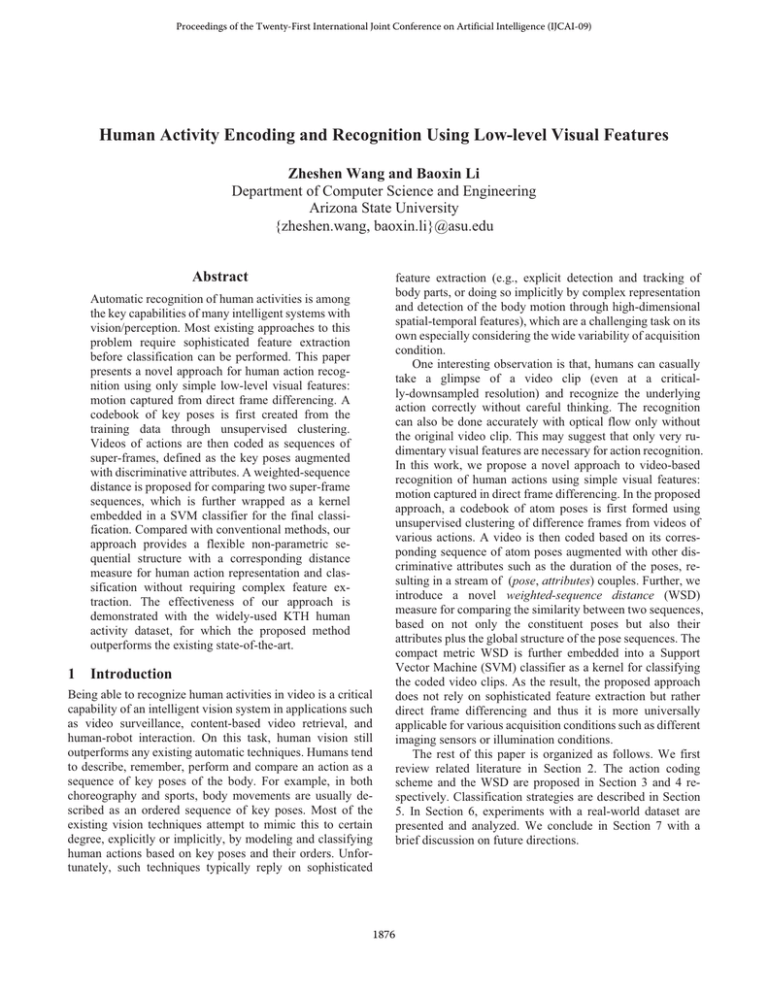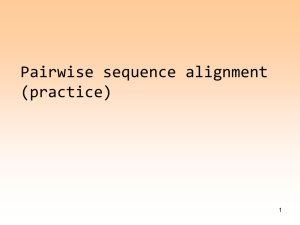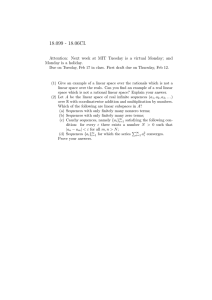Abstract
advertisement

Proceedings of the Twenty-First International Joint Conference on Artificial Intelligence (IJCAI-09)
Human Activity Encoding and Recognition Using Low-level Visual Features
Zheshen Wang and Baoxin Li
Department of Computer Science and Engineering
Arizona State University
{zheshen.wang, baoxin.li}@asu.edu
Abstract
Automatic recognition of human activities is among
the key capabilities of many intelligent systems with
vision/perception. Most existing approaches to this
problem require sophisticated feature extraction
before classification can be performed. This paper
presents a novel approach for human action recognition using only simple low-level visual features:
motion captured from direct frame differencing. A
codebook of key poses is first created from the
training data through unsupervised clustering.
Videos of actions are then coded as sequences of
super-frames, defined as the key poses augmented
with discriminative attributes. A weighted-sequence
distance is proposed for comparing two super-frame
sequences, which is further wrapped as a kernel
embedded in a SVM classifier for the final classification. Compared with conventional methods, our
approach provides a flexible non-parametric sequential structure with a corresponding distance
measure for human action representation and classification without requiring complex feature extraction. The effectiveness of our approach is
demonstrated with the widely-used KTH human
activity dataset, for which the proposed method
outperforms the existing state-of-the-art.
1
Introduction
Being able to recognize human activities in video is a critical
capability of an intelligent vision system in applications such
as video surveillance, content-based video retrieval, and
human-robot interaction. On this task, human vision still
outperforms any existing automatic techniques. Humans tend
to describe, remember, perform and compare an action as a
sequence of key poses of the body. For example, in both
choreography and sports, body movements are usually described as an ordered sequence of key poses. Most of the
existing vision techniques attempt to mimic this to certain
degree, explicitly or implicitly, by modeling and classifying
human actions based on key poses and their orders. Unfortunately, such techniques typically reply on sophisticated
feature extraction (e.g., explicit detection and tracking of
body parts, or doing so implicitly by complex representation
and detection of the body motion through high-dimensional
spatial-temporal features), which are a challenging task on its
own especially considering the wide variability of acquisition
condition.
One interesting observation is that, humans can casually
take a glimpse of a video clip (even at a critically-downsampled resolution) and recognize the underlying
action correctly without careful thinking. The recognition
can also be done accurately with optical flow only without
the original video clip. This may suggest that only very rudimentary visual features are necessary for action recognition.
In this work, we propose a novel approach to video-based
recognition of human actions using simple visual features:
motion captured in direct frame differencing. In the proposed
approach, a codebook of atom poses is first formed using
unsupervised clustering of difference frames from videos of
various actions. A video is then coded based on its corresponding sequence of atom poses augmented with other discriminative attributes such as the duration of the poses, resulting in a stream of (pose, attributes) couples. Further, we
introduce a novel weighted-sequence distance (WSD)
measure for comparing the similarity between two sequences,
based on not only the constituent poses but also their
attributes plus the global structure of the pose sequences. The
compact metric WSD is further embedded into a Support
Vector Machine (SVM) classifier as a kernel for classifying
the coded video clips. As the result, the proposed approach
does not rely on sophisticated feature extraction but rather
direct frame differencing and thus it is more universally
applicable for various acquisition conditions such as different
imaging sensors or illumination conditions.
The rest of this paper is organized as follows. We first
review related literature in Section 2. The action coding
scheme and the WSD are proposed in Section 3 and 4 respectively. Classification strategies are described in Section
5. In Section 6, experiments with a real-world dataset are
presented and analyzed. We conclude in Section 7 with a
brief discussion on future directions.
1876
2 Related Work
Existing approaches for human action recognition can be
generally classified into two categories: graphical-model-based approaches and bag-of-words approaches.
The former utilizes a graphical structure consisting of states
and models the activities as sequential transitions between
the states. Hidden Markov Model (HMM) [Niu and Abdel-Mottaleb, 2005] is one of the most commonly-used examples in this category. Other sophisticated extensions include Abstract HMM [Bui and Venkatesh, 2002], Hidden
Permutation Model [Bui et al., 2008], Relational Markov
Networks [Liao, 2005], etc. While being capable of modeling
temporal transitions in a sequence, these methods usually
suffer from an excess of parameters and overfitting of the
data with insufficient training samples. In addition, the rigid
structure also constrains its flexibility of dealing with structural variations among different sequences. Bag-of-words
approaches have become popular in recent years. Methods in
this category view the activity recognition problem as a
standard classification problem which involves two stages:
feature extraction and classification. Typically, the feature
extraction step is very complex (such as spatial-temporal
word feature proposed in [Dollar et al., 2005]), and additional
pre-processing steps or extra information are often required
(e.g., single action circle segmentation [Schindler and Gool,
2008], accurate alignment [Wong et al, 2007; Kim et al.,
2007], accurate scale information [Liu and Shah, 2008], etc.).
Often, the feature vectors are treated as independent data
points in the classification stage (e.g., [Niebles et al., 2008]).
Therefore, in general, these approaches simplify temporal
sequences into a set of independent features and thus while
local temporal information is encapsulated in the extracted
spatial-temporal descriptors, global temporal information is
not utilized. Nowozin et al. proposed a discriminative subsequence mining approach [Nowozin et al., 2007] which
employs spatial-temporal features provided by [Dollar et al.,
2005] and further formed a sequential representation of the
original videos. However, it does not achieve noticeable
improvements over previous approaches.
The proposed approach attempts to incorporate both local
spatial-temporal information (through unsupervised clustering of motion-capturing difference frames in forming the key
poses) and global temporal structure (through a novel WSD
metric for comparing sequences of poses and an SVM classifier based on it) into a unified action coding and classification scheme.
3
Action Coding
In this section, we present the action coding scheme based on
the (pose, attributes) couples, which is termed as super-frames. Formally, a super-frame f is defined as a 2-tuple
(c, w) which consists of an atom pose c and its attributes w.
The set of atom poses form a codebook. Each frame of a
video is first assigned a codeword c and then adjacent frames
with the same codeword are merged with the attribute w
denoting the duration of the same codeword. With this
strategy, the coded sequence reflects the local spatial-temporal information through the codewords (which are
based on frame differencing) while retaining the global
temporal order of the original sequence. This results in a
compact yet descriptive representation of the original video
clip. Details of codebook learning and sequence coding are
elaborated in the following sub-sections.
3.1 Codebook Learning
We create a codebook from the training data through clustering difference frames, computed as the difference between
two nearby frames (not necessarily consecutive ones if the
video frame rate is high and thus the motion magnitude is not
large between consecutive frames). The distance measure for
clustering is based on Euclidean distance between two difference frames. For simplicity, we will still call the difference
frames as “frames”. The centroids from the clustering stage
are kept as atom poses in the codebook. It is worth emphasizing that, although we use the term “atom pose” for the
codeword, the centroids are not original video frames but
rather a representation of the difference frames, which capture the local spatial-temporal variation of the underlying
actions. (Another reason we use difference frames instead of
the original frames is that they may naturally be robust to
cluttered background since the difference is taken between
nearby frames, which presumably have similar clutter signatures, assuming a decent frame-rate.) A learning approach
automatically covers variations present in the training set,
such as scale changes. Figure 1 illustrates some sample atom
poses and their corresponding video frames.
A
B
C
D
E
F
G
Figure 1: An illustration of atom poses (the top row) and their corresponding video frames (the bottom row).
Like any unsupervised clustering scheme, the choice of
the number of clusters is an issue. To address this problem,
we introduce a distance matrix which records pair-wise
Euclidean distances (normalized to [0, 1]) among all codewords in the codebook. The distance matrix is then taken into
consideration in computing the weighted-sequence distance
between two super-frame sequences. More details are discussed in Section 4.
3.2 Video Coding Based on Super-frames
With an established codebook, we code a given video clip by
the following three steps: (1) Assign a codeword to each
frame based on similarities between the frame and each codeword; (2) Group adjacent frames with the same codeword
1877
and store the duration of the codeword in the attribute, resulting in a super-frame; (3) Store all the super-frames in
their original temporal order in the video.
Figure 2 illustrates two coded sequences using key poses
in Figure 1.
(ci(1) , wi(1) ) : (A, 4)
(B, 5) (C, 4) (D, 5) (C, 6) (B, 6)
(a) Super-frame sequence s(1) for a “hand clapping” clip
(2)
:
(c (2)
j , wj )
(A, 6) (F, 7)
(G, 8) (F, 5)
(E, 4)
(b) Super-frame sequence s(2) for a “hand waving” clip
Figure 2: Two examples of coded sequences (Weights here are
shown as the number of frames each group includes. In the
experiments, we use normalized frame numbers as weights.)
4
Firstly, “characters” in a super-frame sequence are atom
poses with corresponding weights (which may reflect the
significance of the atom pose). Intuitively, operations on a
crucial atom pose (e.g., one lasting for a longer period)
should cost more than on a less important one. For example,
deleting a super-frame of significant length during comparison should result in a large cost for a relative short video.
Secondly, the similarity between the atom poses varies and
thus in operations, such as Substitution, the cost of the operation relies on what to use for the replacement. For example,
in Figure 3, we assume that the distance between two characters equals the color difference between the corresponding
bars. Obviously, to substitute “B” in the “ABC” sequence,
“D” would cost less than using “E”, since the color of “D” is
much closer to “B” than “E”. As mentioned earlier, such
information is kept in a distance matrix in the codebook
creation step and thus we should be able to systematically
address such issues.
In the following sub-sections, we propose a
weighted-sequence distance (WSD), which is able to address
both of the above practical issues.
4.1 WSD for Super-frames
Weighted-sequence Distance
After a video clip is coded as a super-frame sequence, action
recognition boils down to classification of the super-frame
sequences, for which a measure of the distance between two
data points (super-frame sequences) is needed. In this section, we propose a generalized version of the classical Levenshtein Distance (also known as String Edit Distance
[Levenshtein, 1966]), which takes both the attribute and the
character (codeword) distances into consideration.
String distance/similarity problems widely appear in many
areas of computer science. For example, in Web search,
string matching/text comparison is one of the basic problems
for text-based retrieval (e.g., [Crochemore and Rytter, 1994];
[Cancedda et al., 2003]); in computational biology, string
matching techniques are often used for comparing biological
patterns (e.g., [Leslie et al., 2004]). Edit distance, a basic
string similarity metric, is defined as the minimum number of
operations (including Copy/Substitution, Insertion and Deletion) required for turning one string to the other [Levenshtein, 1966]. Typically, fixed costs are assigned to each
operation respectively in computing the overall cost of a
series of editing operations. This formulation assumes that
characters are of equal importance and that distance between
two characters is binary (either “same” or “different”).
However, in our problem of comparing super-frame sequences, these assumptions are no longer reasonable.
We define a weighted character a (e.g., the super-frame f in
our problem) as a 2-tuple (c, w) which consists of the label c
(e.g., the codeword in our super-frame formulation) and its
weight w. Then a weighted string can be written as
(1)
s {a1 , a2 ,..., an }, ai (ci , wi ), i 1,..., n
where n is the number of characters in s . Assume that we
have two weighted strings s(1) and s(2):
s (1)
{a1(1) , a2(1) ,..., an(1)1 }, ai(1)
( ci(1) , wi(1) ), i 1,..., n1 (2)
s ( 2)
{a1( 2) , a2( 2) ,..., an( 22 ) }, a (j 2)
(c (j 2) , w (j 2) ), j 1,..., n2 (3)
A (n1 n2 ) (n1 n2 ) symmetric matrix Dc (with zero elements on the diagonal) records pair-wise distances of the
vocabulary (range of values in Dc is [0, 1]):
(4)
{c1(1) , c2(1) ,..., cn(1)1 , c1( 2) , c2( 2) ,..., cn( 22) }
Then the weighted-sequence distance between s(1) and s(2) is
defined as the sum of costs caused by operations for turning
s(1) to s(2):
(5)
DWSD ( s(1) , s (2) )
Costl
l 1,..., L
in which L is the number of operations involved; Costl denotes the required cost for the lth operation. Three types of
editing operations: Substitution, Insertion and Deletion and
corresponding costs are defined as follows:
Cost S (a(1) , a(2) )
Cost I (a (1) , a (2) )
Cost D ( a (1) , a (2) )
Figure 3: An illustration of distances between two characters.
S
(1)
1
| w(1) w(2) | min{w(1) , w(2) } Dc (c(1) , c(2) ) (6)
w(2)
2
3
(2)
w(1)
(7)
(8)
(1)
where Cost (a , a ) denotes the cost of substituting a in
s(1) by a(2) from s(2). CostI(a(1), a(2)) indicates inserting a(2) to
1878
s(1). CostD(a(1), a(2)) means deleting a(1) from s(1) when comparing a(1) and a(2). 1 , 2 and 3 are weights for balancing
the components. We use 1
1/ k in our experi2
3
ments, where k is the codebook size.
With the above definitions, we propose an algorithm as
shown in Figure 4 for computing the WSD by extending the
conventional Edit Distance algorithm based on dynamic
programming. Landau and Vishkin [Landau and Vishkin,
1989] have shown that classical edit distance problem can be
solved in O(mn) time using dynamic programming. Since our
generalized version does not change the structure of the
original algorithm, it still maintains the same computational
complexity.
Algorithm: Weighted-Sequence Distance (WSD) computes the weighed-sequence distance between two
weighted-sequences s(1) and s(2) with given distance matrix Dc.
Input: Weighed-sequence s(1) and s(2) and distance
matrix Dc.
1 if n1 = 0
;
2
return
w(2)
j
end
if n2 = 0
return
wi(1) ;
i 1,..., n1
6 end
7 Construct an empty matrix M ;
8 Initial the first row of M as w11,(w11 w12 ),...,
wi1 ;
i 1,...,n1
9 Initial the first column of M as w12 ,(w12 w22 ),...,
w2j ;
j 1,...,n2
10 while i n1 do
11
while j n2 do
12
Compute the following costs respectively:
13
Cost copy / substitution
14
Cost insertion
;
Cost I (ai(1) , a(2)
j )
15
Cost deletion
;
Cost D (ai(1) , a(2)
j )
16
Let M (i 1, j 1)
;
Cost S (ai(1) , a(2)
j )
17
min{M (i, j 1) Cost insertion ,
18
deletion
M (i 1, j ) Cost
19
20
end
21 end
22 DWSD M (n1 1, n2
WSD
23 return D
M (i, j ) Cost
In this sub-section, we analyze the properties of the WSD
defined in the previous subsection, which serve to verify that
WSD is a desired distance measure for comparing two
weighted-sequences.
Property 1 (Zero Copy Cost): Assume that a(1) = (c(1),w(1))
and a(2) = (c(2),w(2)) are two weighted characters from sequence s(1) and s(2), respectively. If Dc(c(1), c(2)) = 0 and
w(1)=w(2), then the substitution cost for a(1) and a(2) in turning
s(1) and s(2) equals zeros:
(9)
Cost S ( a (1) , a (2) ) 0
This property can be easily proved by inserting Dc(c(1),c(2))=0
and w(1)=w(2) into Eq. (6). It means that when the two
weighted characters are equal, Substitution is reduced to
Copy and its cost becomes zero.
Property 2 (Commutative Law): Assume that s(1) and s(2)
are two weighted-sequences and the weights of Insertion and
Deletion costs ( 2 and 3 in Eq. (7) and Eq. (8)) are equal.
The cost of turning s(1) to s(2) equals the cost of turning s(2) to
s(1):
j 1,..., n2
3
4
5
4.2 Properties of WSD
(10)
DWSD ( s (1) , s (2) ) DWSD ( s (2) , s (1) )
Proof: If we can prove that the costs of any operations for
turning s(1) to s(2) equal the cost of those for turning s(2) to s(1),
Property 2 is proved. Substitution cost defined in Eq. (6)
obeys Commutative Law. For Insertion and Deletion, inserting a(2) to s(1) in turning s(1) to s(2) is essentially the same as
deleting a(2) from s(2) in its inversed process—turning s(2) to
s(1). According to Eq. (7) and (8), we have
Cost I ( a (1) , a (2) ) Cost D ( a (2) , a (1) )
Similarly, we can obtain
Cost D ( a (1) , a (2) ) Cost I ( a (2) , a (1) )
Thus Eq. (10) is always held.
For properties 3-6, we assume there are three
weighted-sequences s(1), s(2) and s(3) which are of the same
length.
Property 3 (Character Variation): If all corresponding
weights of three sequences are equal
wi(1) wi(2) wi(3) , i 1,.., n
while there are p characters in s(2) and q characters in s(3)
which are different from the corresponding characters in s(1)
and the corresponding character distances are all equal to 1:
Dc (cx(1)j , cx(2)j ) 1, j 1,..., p, xj [1, n]
,
copy / substitution
Dc (cx(1)k , cx(3)k ) 1, k 1,..., q, xk [1, n]
};
and p>q, then DWSD ( s (1) , s (2) ) DWSD ( s (1) , s (3) ) .
1) ;
.
Figure 4: Weighed-sequence distance (WSD) algorithm.
Property 4 (Order Variation): Assume that s(1), s(2) and s(3)
consist of the same set of elements (tuples of characters and
corresponding weights), but with different order. If there are
p and q elements in s(2) and s(3) respectively, which are different from the corresponding elements in s(1):
1879
weighted-sequence distance, we define a WSD kernel function as
(11)
exp(
DWSD ( s (1) , s (2) , Dc )),
0
ax(1)j ax(2)j , j 1,..., p, xj [1, n]
ax(1)k ax(3)k , k 1,..., q, xk [1, n]
and
(2)
xr
p q, a
(3)
xr
a , r 1,..., q
then DWSD ( s (1) , s (2) ) DWSD ( s (1) , s (3) ) .
Property 5 (Weight Variation): If all corresponding characters of three sequences are equal
ci(1) ci(2) ci(3) , i 1,.., n
while there are p weights in s(2) and s(3) respectively, which
are different from the corresponding ones in s(1):
wx(1)j wx(2)j , wx(1)j wx(3)j , j 1,..., p, xj [1, n]
6
and
(1)
xj
(2)
xj
|w
(1)
xj
(3)
xj
w | |w
w |, j 1,..., p, x j [1, n]
then DWSD ( s (1) , s (2) ) DWSD ( s (1) , s (3) ) .
Property 6 (Character Distance Variation): If all corresponding weights of three sequences are equal
wi(1) wi(2) wi(3) , i 1,.., n
while there are p characters in s(2) and s(3) respectively, which
are different from the corresponding characters in s(3) and
Dc (cx(1) , cx(2)j ) Dc (cx(1) , cx(3)j ), j 1,..., p, x j [1, n]
j
WSD
j
(2)
WSD
then D ( s , s ) D ( s (1) , s (3) ) .
Properties 3-6 can all be proved formally but we skip the
proofs due to the space limitation. These properties show that
when variations involved are increased, WSD between the
reference sequence and the new created sequence raises
monotonically. They coincide with our heuristic requirements in terms of characters, weights of characters, distances
of characters and sequential order of characters for measuring the distance between two weighed-sequences.
5
(1)
in which is a model parameter. In our experiments, we use
LibSVM [Chang and Lin, 2001] with kernels computed from
our kernel function defined in Eq. (11). Model parameter
is selected from an n-fold cross validation on the training set.
Since the kernel matrix is not always positive semi-definite,
to guarantee a global optimum in SVM, we revise the kernel
matrix through shifting all the eigen values by a positive
constant [Roth et al., 2003]. The constant is set as the absolute value of the minimum eigen value in our experiments.
Experiments
In order to verify the effectiveness of our proposed algorithm,
we performed experiments with a real-world human activity
recognition dataset.
The KTH human activity dataset [Schuldt et al., 2004]
contains 6 human actions (walking, jogging, running, boxing,
hand waving and hand clapping) performed by 25 subjects in
4 different scenarios: outdoors, outdoors with scale variation,
outdoors with different clothes and indoors (599 video clips
available in total with a 25 fps frame rate). Figure 5 shows
some sample frames from the 6 actions under 4 scenarios.
We can see that this dataset covers subject variation, appearance variation, scale variation, illumination variation,
and action execution variation, and thus it is deemed as very
challenging.
Weighed-sequence Classification
With the distance measure WSD proposed in Section 4,
classification algorithms can be designed for the weighedsequences (the super-frame sequences). In our experiment,
we use both 1-Nearest Neighbor (1-NN) strategy based on
WSD and an SVM classifier [Cristianini and Shawe-Taylor,
2000] with our WSD kernel.
For non-numerical data, one possible solution of using
SVM is revising non-numerical data to numerical (e.g., using
binary digits to represent a categorical attribute [Chang and
Lin, 2001]). In addition, it can be solved by using sequence
based kernels, such as the string kernel used for text documents [Cancedda et al., 2003], sequence kernels for speaker
recognition [Campbell, 2001] or protein classification [Leslie
et al., 2004]. However, to the best of our knowledge, none of
existing string/sequence kernels is able to deal with
weighted-sequence. In this paper, based on our proposed
Figure 5: Sample frames from KTH dataset: row—action, column—scenario.
1880
In our experiments, we first compute frame differences for
the first 204 frames in each sequence with a step size 4. (200
difference frames obtained for each sequence.) In order to
reduce dimension, we crop out the human body regions by
using an 80 pixel 100 pixel bounding box. For hand motion
sequences without scale variations, we manually set a fixed
cropping region for the first frame of each sequence and use
it for the entire sequence; for the remaining sequences, we
estimate the center of the cropping region by using the center
of the foreground pixels in the difference frames. We further
sub-sample the sequences spatially to 1/ 4 of the original size
and temporally by a factor of 3, resulting in 67 difference
frames for each video clip to be used as input for classification. Compared to the strong assumptions required in some
other work (discussed in the related work and the following
experiment analysis part), our preprocessing steps are by
design very simple and the obtained results are still quite
noisy in reality.
Figure 6: Samples of obtained atom poses.
%
Box
Clap
Wave
Jog
Run
Walk
Box
88
14
6
0
0
0
Clap
9
81
11
0
0
0
Wave
3
3
83
0
0
0
Jog
0
0
0
70
27
8
Run
0
0
0
22
73
2
Walk
0
2
0
8
0
91
of the number of clusters in creating the codebook is not
critical. Figure 6 shows some sample codewords of the atom
actions (cluster centroids) from our unsupervised classification. As we can expect, results of such simple clustering
strategy applied on the inaccurately-cropped regions are very
noisy. However, our weighted-sequence distance naturally
incorporates the global temporal structure of the sequences in
computing the final measure. The noisy, individual results
are actually implicitly filtered during the computation. And
the 87.8% average classification accuracy (see Table 3) further verified that our proposed approach is robust to noise
and works well for data obtained from low-level visual features without using sophisticated feature extraction.
For algorithm training and testing, we use sequences from
9 random selected subjects for creating the codebook and
adopt the leave-one-out (LOO) testing paradigm, which is
employed by all but one of the reference algorithms chosen
for comparison. Each LOO round consists of sequences from
24 subjects for training and those from the remaining one for
testing. Excluding sequences from those 9 subjects which are
used for creating the codebook, 16 LOO rounds were run.
Results are shown in Table 1 and Table 2. It was found that
the best performance was obtained by the proposed WSD
kernel SVM classifier (which is better than the 1-NN classifier with WSD by 6.8% on average).
Several most recent state-of-the-art approaches are chosen
for comparison. These include Niebles et al.’s work [Niebles
et al., 2008], Dollar et al.’s work [Dollar et al., 2005], and
Nowozin et al.’s result [Nowozin et al., 2007]. (Although
some other methods also reported results on the same dataset,
they were not selected for comparisons here since they rely
on excessive manual segmentation or strong assumption of
the availability of accurate preprocessing steps for feature
extraction, which may significantly boost the performance.
For example, [Schindler and Gool, 2008; Fathi and Mori,
2008; Mikolajczyk and Uemura, 2008] require accurate
bounding box for each frame and [Liu and Shah, 2008] assumes accurate scale information for each frame. Both of the
assumptions explicitly avoid the scale variation problem,
which occurs in 1/4 of the sequences in KTH dataset.)
%
Table 1: Results using 1-NN classifier with WSD measurement.
%
Box
Clap
Wave
Jog
Run
Walk
Box
94
9
6
0
0
0
Clap
6
91
8
0
0
0
Wave
0
0
86
0
0
0
Jog
0
0
0
80
16
8
Run
0
0
0
8
84
0
Our (1-NN)
Walk
0
0
0
13
0
92
Our (SVM)
Niebles et al ’08
Dollar et al. (1-NN)
Dollar et al. (SVM)
Nowozin et al ’07
Box Clap Wave Jog Run Walk Ave
88
94
98
80
85
86
81
91
86
82
77
89
83
86
93
84
93
92
70
80
53
63
57
69
73
84
88
73
85
86
91
92
82
89
90
86
81.0
87.8
83.3
78.5
81.2
84.7
Table 3: Comparisons to state-of-the-art results on KTH dataset
Table 2: Results using SVM classifier with WSD kernel.
In the codebook creation step, we set the cluster number as
30 for our experiments. As mentioned in the previous part,
we take the distances among codewords into consideration in
computing the weighted-sequence distance, thus the choice
It was found that the WSD kernel SVM algorithm is able to
outperform each of the reference methods in terms of overall
accuracy, as shown in Table 3. Further, we can also observe
from Table 3 that our algorithm is able to discriminate well
“jogging”, “running” and “walking” classes, which are good
examples where the global temporal structure of the se-
1881
quences are key to correct classification. This suggests that
the proposed super-frame coding strategy is able to retain the
global temporal information as desired. It is worth pointing
out that both versions of the proposed methods (1-NN-based
and SVM-based) outperform the corresponding algorithms
from Dollar et al.
7 Conclusion and Future Work
We proposed an approach for human action recognition
based on a novel super-frame-based coding scheme and a
novel weighted-sequence distance for comparing super-frame sequences. Our approach takes into consideration
both local and global spatial-temporal structures of an action
that are deemed as critical for classification. The approach
has been evaluated on a challenging real database and was
found to be able to outperform many existing state-of-the-art
approaches by a non-trivial margin, even if it uses very simple low-level visual features as the input.
There is still much room for further improving our work.
For example, in our current work, we only use the temporal
length of the atom poses as the attributes. Other information
or features that may contribute to better discrimination of the
actions can also be added to the attributes for each atom pose.
Also, in our experiments, while the chosen dataset is challenging and has been widely-used, it does not include multiple actions/subjects and appearance variations due to view
angle changes. Our future work includes evaluating and
extending the proposed method to cover more complex cases.
In addition, we also plan to explore the application of the
proposed WSD on other problems where comparison between sequences of symbols with attributes is involved.
References
[Bui and Venkatesh, 2002] H. H. Bui and S. Venkatesh. Policy
Recognition in the Abstract Hidden Markov Model. Journal of
Artificial Intelligence Research, vol. 17, pp. 451-499, 2002.
[Bui et al., 2008] H. H. Bui, D. Phung, S. Venkatesh, and H. Phan.
The Hidden Permutation Model and Location-Based Activity
Recognition. National Conference on Artificial Intelligence
(AAAI), 2008.
[Campbell, 2001] W. M. Campbell. A Sequence Kernel and its
Application to Speaker Recognition. Neural Information
Processing Systems, vol. 14, pp. 1157-1163, 2001.
[Cancedda et al., 2003] N. Cancedda, E. Gaussier, C. Goutte, and J.
M. Renders. Word Sequence Kernels. The Journal of Machine
Learning Research, vol. 3, pp. 1059-1082, 2003.
[Chang and Lin, 2001] C.-C. Chang and C.-J. Lin. LIBSVM : a
library for support vector machines. Software available at
http://www.csie.ntu.edu.tw/~cjlin/libsvm.
[Cristianini and Shawe-Taylor, 2000] N. Cristianini and J.
Shawe-Taylor. An Introduction to Support Vector Machines
and Other Kernel-based Learning Methods: Cambridge University Press, 2000.
[Crochemore and Rytter, 1994] M. Crochemore and W. Rytter. Text
Algorithms: Oxford University Press, 1994.
[Dollar et al., 2005] P. Dollar, V. Rabaud, G. Cottrell, and S. Belongie. Behavior Recognition Via Sparse Spatio-temporal
Features. 2nd Joint IEEE International Workshop on Visual
Surveillance and Performance Evaluation of Tracking and
Surveillance, 2005.
[Fathi and Mori, 2008] A. Fathi and G. Mori. Action Recognition by
Learning Mid-level Motion Features. IEEE International
Conference on Computer Vision and Pattern Recognition
(CVPR), 2008.
[Kim et al., 2007] T. Kim, S. Wong and R. Cipolla. Tensor Canonical Correlation Analysis for Action Classification. IEEE
International Conference on Computer Vision and Pattern
Recognition (CVPR), 2007.
[Landau and Vishkin, 1989] G. Landau, and U. Vishkin. Fast parallel and serial approximate string matching. Journal of Algorithms, vol. 10, 157–169, 1989.
[Leslie et al., 2004] C. Leslie, E. Eskin, A. Cohen, J. Weston, and a.
W. S. Nobley. Mismatch String Kernels for Discriminative
Protein Classification. Bioinformatics Advance Access, vol. 20,
pp. 467-476, 2004.
[Levenshtein, 1966] V. I. Levenshtein. Binary Codes Capable of
Correcting Deletions, Insertions and Reversals. Soviet Physic
Doklady, vol. 10, pp. 707-710, 1966.
[Liao et al., 2005] L. Liao, D. Fox, and H. Kautz. Location-based
Activity Recognition Using Relational Markov Networks.
International Joint Conference on Artificial Intelligence
(IJCAI), 2005.
[Liu and Shah, 2008] J. Liu and M. Shah. Learning Human Actions
via Information Maximization. IEEE International Conference
on Computer Vision and Pattern Recognition (CVPR), 2008.
[Mikolajczyk and Uemura, 2008] K. Mikolajczyk and H. Uemura.
Action Recognition with Motion-Appearance Vocabulary
Forest. IEEE International Conference on Computer Vision
and Pattern Recognition (CVPR), 2008.
[Niebles et al., 2008] J. C. Niebles, H. Wang, and L. Fei-Fei. Unsupervised Learning of Human Action Categories Using Spatial-Temporal Words. International Journal of Computer Vision, vol. 79, pp. 299-318, 2008.
[Niu and Abdel-Mottaleb, 2005] F. Niu and M. Abdel-Mottaleb.
HMM-Based Segmentation and Recognition of Human Activities from Video Sequences. IEEE International Conference
on Multimedia and Expo (ICME), 2005.
[Nowozin et al., 2007] S. Nowozin, G. Bakir, and K. Tsuda. Discriminative Subsequence Mining for Action Classification.
IEEE International Conference on Computer Vision (ICCV),
2007.
[Roth et al., 2003] V. Roth, J. Laub, M. Kawanabe, and J. M.
Buhmann. Optimal cluster preserving embedding of nonmetric
proximity data. IEEE Transactions on Pattern Analysis and
Machine Intelligence, 25, 1540–1551.
[Schindler and Gool, 2008] K. Schindler and L. v. Gool. Action
snippets: How many frames does human action recognition
require? IEEE International Conference on Computer Vision
and Pattern Recognition (CVPR), 2008.
[Schuldt et al., 2004] C. Schuldt, I. Laptev, and B. Caputo. Recognizing Human Actions: A Local SVM Approach. International Conference on Pattern Recognition (ICPR), 2004.
[Wong et al., 2007] S. Wong, T. Kim and R. Cipolla. Learning
Motion Categories using both Semantic and Structural Information. IEEE International Conference on Computer Vision
and Pattern Recognition (CVPR), 2007.
1882







